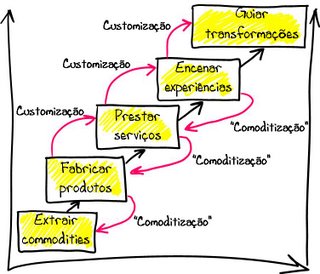Por um lado, estamos praticamente todos de acordo que a "servitização" é um facto.
.
Cada vez mais, os produtos fabricados são um artificio para o desenvolvimento de uma relação. Cada vez mais camadas de serviços são fundidas com os produtos criando um híbrido.
.
A lógica da servitização é a de fugir à comoditização crescente dos produtos. Produzir é fácil, produzir é o mais fácil. Quem compete na produção de produtos, aposta na escala, no volume, por isso, recorre o mais possível à uniformização, à padronização que reduz custos e aumenta a eficiência.
.
O que acontece é que a mentalidade eficientista invade a parcela do serviço e comoditiza-a eliminando a vantagem que ele poderia trazer.
.
"
Many service companies just aren’t designed for service delivery. They are designed like factories, optimized for the mass-production of inputs into outputs. This makes perfect sense in a rapidly-industrializing economy. But in an economy where manufacturing is shrinking and services are expanding, it doesn’t work anymore.
.
Traditional management thinking looks at a customer service call as an input to the “service factory.”
Most companies try to standardize these inputs as much as possible so they can process them efficiently. The factory’s job is to produce “resolutions.” This is how we end up with complicated voice menu systems that attempt to route calls to the appropriate department while keeping costs as low as possible.
...
In a service-driven marketplace, the focus needs to shift from the line of production to a different line; the front line. The line of production is a one-way arrow, starting with raw materials and suppliers and ending with the customer who buys the product.
...
A production line requires efficiency.(
Moi ici: Depende da proposta de valor) Inputs can be standardized, and environments and processes can be internally controlled.
But a front line requires optionality. Front line people deal with environments and circumstances that cannot be predicted."
.





%2006.21.jpeg)












